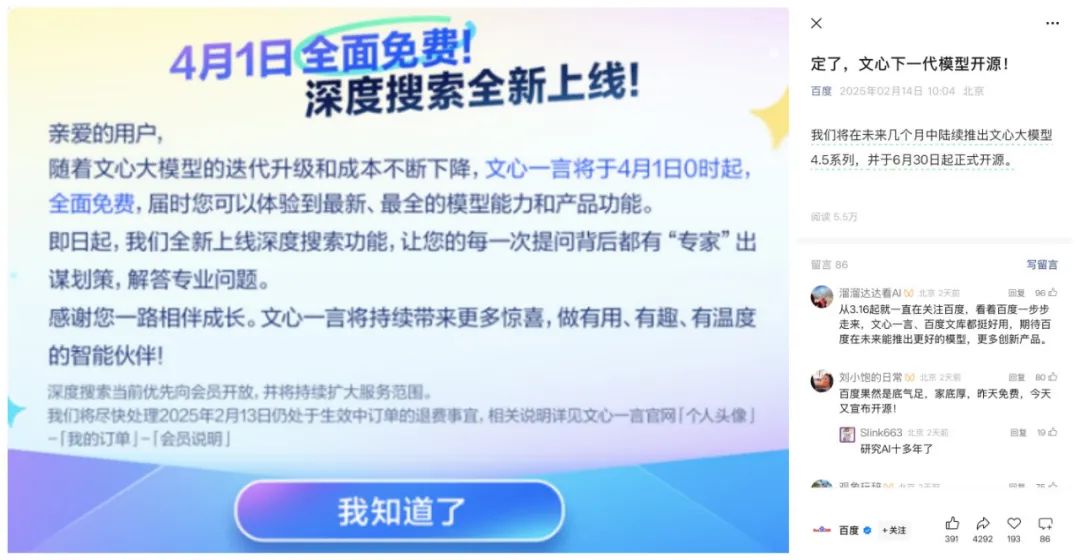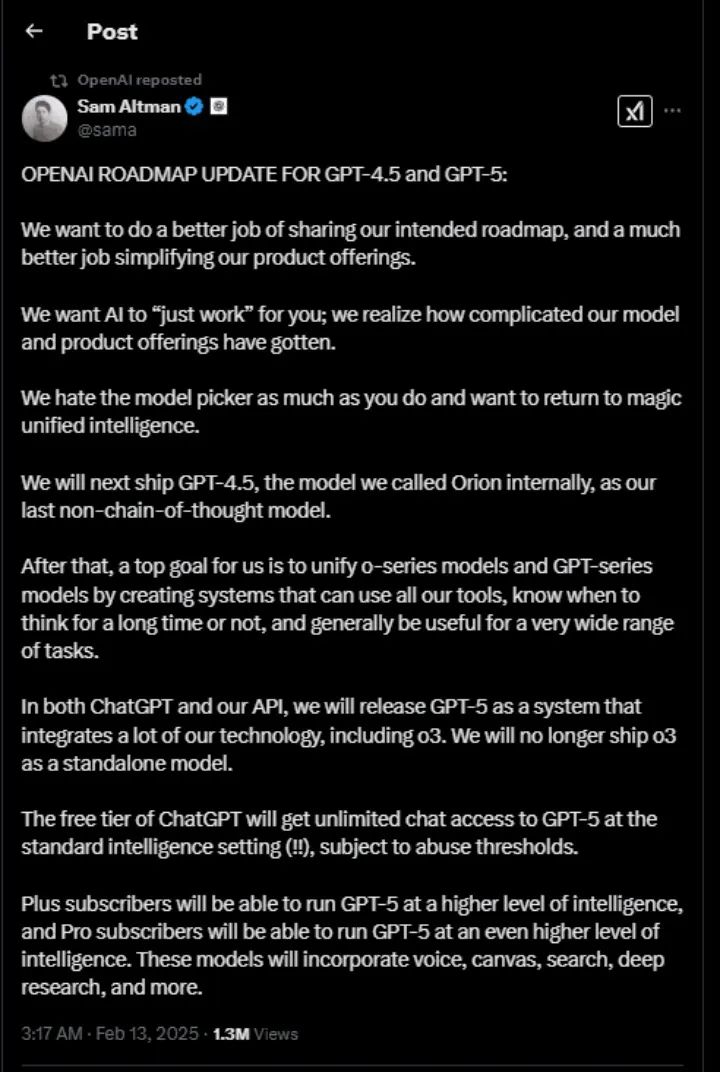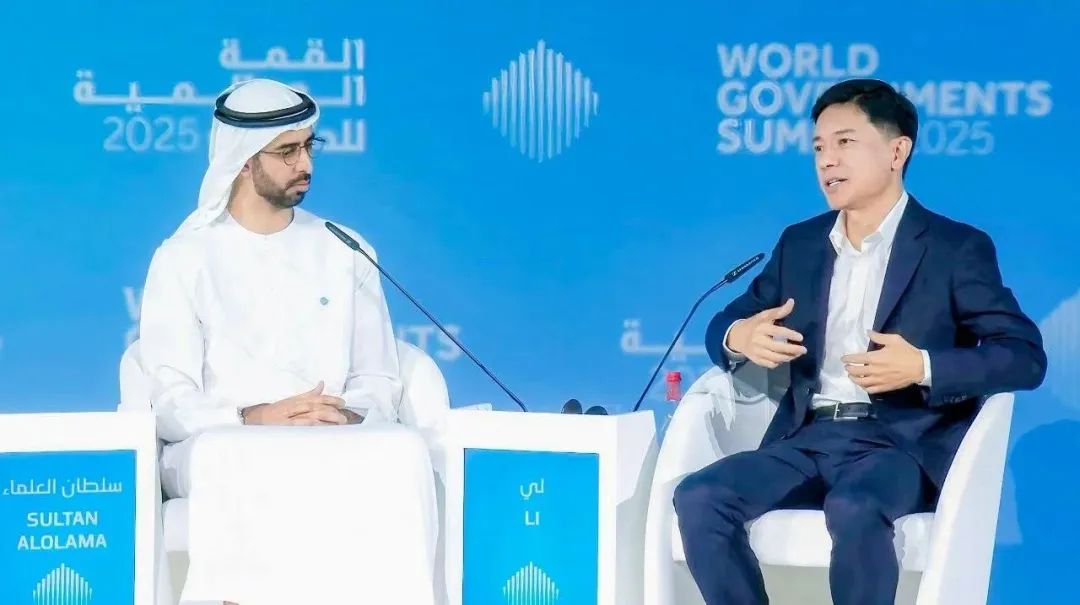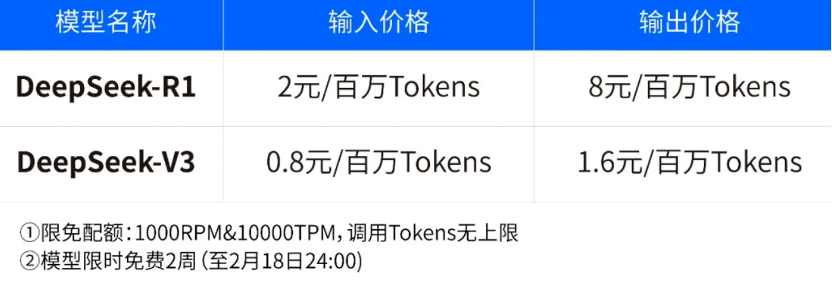Announcing Free and Open-Source Initiatives: Deciphering Baidu's New AI Strategy
![]() 02/17 2025
02/17 2025
![]() 367
367
Typesetting | Xiaoying
At the dawn of 2025, the global race for AI large models appears to have shifted into a new paradigm: one focused on openness and open sourcing. Recently, Baidu made significant announcements. Firstly, it revealed that ERNIE Bot would be entirely free and unveiled the forthcoming release of the ERNIE large model 4.5 series, set to be officially open-sourced from June 30.

Almost simultaneously, OpenAI announced that the new GPT-5 large model would be unlimitedly accessible to ChatGPT's free users. CEO Sam Altman mentioned that internal discussions were underway regarding the potential open sourcing of the model.

Open sourcing, a model that once revolutionized the software landscape, is now sweeping through the AI large model industry with unstoppable momentum. So, what are the unique facets of these tech giants' open-source strategies? And in the cutthroat competition for AI large models, how will open sourcing play a pivotal role?
| Open Sourcing Becomes the Mainstream |
| From "Technical Barriers" to "Ecological Weapons" | Tech giants are embracing free, open, and open-source models, signaling a shift in the large model competition from "technological hegemony" to "ecological positioning." This resembles the "iOS vs Android" battle in mobile operating systems. Almost two decades ago, in the face of the dominant iOS, Android successfully lured more manufacturers into its camp with its open-source strategy, catering to the needs of diverse user groups through innovation and customization. It can be argued that open sourcing facilitated the widespread adoption of Android, enabling it to surpass iOS and become the mobile operating system with the largest market share. Similarly, in the realm of AI large models, technical barriers were once the core of competition, with companies fortifying their advantages through closed sourcing. However, with rapid technological advancements and decreasing costs, open sourcing and closed sourcing are no longer paramount. What matters more is the model's performance. Currently, large models are entering an era of cost reduction, where open sourcing can not only accelerate technology dissemination and innovation but also attract more developers and enterprises to participate, collectively fostering a robust ecological alliance, fostering stronger synergies, and becoming a driving force behind the explosion of large model applications.
Recently, Baidu founder Robin Li stated at a summit, "Open sourcing garners more attention. We are in the nascent stages of AI and generative AI innovation. Faster dissemination will boost adoption rates and encourage more people to try this technology." Open sourcing is not an end goal but a means to minimize the barriers to acquiring new technologies, thereby drawing more practitioners into ecosystem building. Ecosystem building under the trend of open sourcing will be the key for enterprises to thrive in the future of AI. In the future, the competition for AI large models will transcend mere technological rivalry; it will also be an ecological competition. Players who can own large model ecosystems and enjoy higher user loyalty will prevail.
| Open AI vs Baidu |
| "Open Strategies" and "Ambitions" Behind Open Sourcing | The open sourcing and closed sourcing of technology are not matters of good or bad, this or that; they can even coexist as enterprises make different choices regarding how and to what extent to open source, depending on the stage of industrial development. Moreover, in the early stages of industry development, when some vendors claim to open source models, it sometimes feels more like marketing. Overseas research teams have discussed the scenarios of "Llama 2" and other AI large models that are "open sourced" to some extent, stating that some models under the banner of "open source" may have some "traps." For instance, Meta's Llama only open-sourced some parameters and configuration files, limiting users' ability to experiment and develop adaptations, essentially being only "half open-sourced."
Entering 2025, the decrease in large model inference costs and rapid technological iterations have made it feasible for large models to be further opened and open-sourced. Robin Li said at the World Governments Summit 2025 held in Dubai, United Arab Emirates, "Today, the speed of innovation is much faster than ever before. In Moore's Law, performance doubles every 18 months, and prices are halved; nowadays, large model inference costs can be reduced by more than 90% annually."

However, although both OpenAI and Baidu are advancing open sourcing, their strategies differ, resulting in a "generational gap." While Sam Altman has pondered over open sourcing, and OpenAI is also considering open sourcing models, Kevin Weil, Chief Product Officer of OpenAI, revealed that the company is contemplating open sourcing older, less advanced AI models. While OpenAI is still planning how to open source "cleverly," Baidu has taken the lead in deciding to open source the latest generation of models.
In comparison, Baidu's open-source strategy seems a bit "radical," which may be attributed to Baidu holding a more "potent" technical trump card. Baidu possesses Kunlun, a self-developed AI chip, with significant cost-performance advantages, functioning as a powerful "heart" to fuel model computations; the scale effect of the 10,000-card cluster acts like "muscle groups," enabling efficient integration and utilization of computing power; combined with the efficient deployment management of the Baige platform, it acts like a precise "nervous system," coordinating resources from all parties to enable stable task execution by large model clusters.

More notably, Baidu is the only company in China to achieve a four-layer AI full-stack architecture. Thanks to this edge, cloud infrastructure, frameworks, large models, and terminal application scenarios can form an efficient feedback loop, aiding large models in continuous optimization and iteration, achieving end-to-end optimization. This not only markedly enhances the efficiency of model training and inference but also further reduces overall costs. It is precisely because of these technological advantages that Baidu AI has significantly reduced costs from training to inference. Recently, the R1 and V3 models of DeepSeek have also been integrated into Baidu Qianfan's large model platform, offering industry-leading ultra-low inference prices, as low as 30% of DeepSeek's official pricing. On the first day of model launch, over 15,000 customers invoked models through the Qianfan platform.

At the same time, Baidu's investment in infrastructure continues. Robin Li said, "We still need to continuously invest in chips, data centers, and cloud infrastructure to build better and smarter next-generation models." With these advantages, Baidu has laid a solid foundation and demonstrated robust technological confidence when deciding to open source.
| Beyond the Open Source Debate |
| In the Era of 90% Cost Reduction, Who Can Define AI's "Killer Scenario"? | Although large model vendors adopt different routes for open sourcing and closed sourcing, and even if they choose to open source, they employ varied strategies, the core of their iterations cannot be divorced from one point: model performance and cost must meet the demands of a wide range of applications. As large models enter the era of comprehensive cost reduction and efficiency enhancement, with costs rapidly declining, large models will witness a moment of application explosion, and the importance of applications far outweighs that of model open sourcing and closed sourcing. As Robin Li noted, "Ultimately, what matters most is application, not which large model is used. Regardless of whether it is open source or closed source, what matters more is the value that can be created at the application layer." Large model vendors aim to build an ecosystem through open sourcing, which is a test of their technological innovation and cost reduction capabilities, as well as a test of their landing applications.
Two years ago, Robin Li proposed using AI to revamp all Baidu products. In these two years, Baidu's seasoned products, Baidu Wenku and Baidu Netdisk, which have been reconstructed by AI, have regained new vitality. According to public information, the MAU of Baidu Wenku's AI function has surpassed 90 million, with a year-on-year increase of 230% in AI DAU and over 40 million paid users, ranking second globally and first in China, while the user base of Baidu ERNIE Bot has also reached 430 million. Beyond C-end applications, for B-end applications, in August last year, the daily average invocation volume of Baidu's ERNIE large model exceeded 600 million times, the highest in China. Nowadays, there will also be a significant increase post open sourcing. Baidu's Intelligent Cloud Qianfan large model platform has assisted customers in fine-tuning 33,000 models, developing 770,000 enterprise applications, and has accessed over 100 mainstream large models from home and abroad. In the 2024 large model bid review, Baidu Intelligent Cloud won multiple first places. Additionally, according to foreign media reports, Apple continues to collaborate with Baidu to develop AI functions for Chinese iPhone users, accelerating the implementation of edge AI. Baidu has been at the forefront of large model application implementation. With the explosion of applications under the industry open source trend, it is anticipated to continue to lead the pack.
In the past, China lagged behind in the construction of technological ecosystems. Due to insufficient technological accumulation and innovation capabilities, coupled with factors such as the low openness of the domestic developer ecosystem and the low degree of global collaboration, domestic software products were mostly followers and imitators, lacking originality, and China was in a state of following for a long time. For instance, Windows became the mainstream operating system in the PC era with its strong compatibility and rich software support; Linux occupied an important position in the server and embedded system fields with its open source and stability; in the smartphone era, Apple and Android ecosystems compete. However, China lacks such original technological ecosystems. Nonetheless, in the AI era, open sourcing presents a new opportunity for China to develop technological ecosystems. Baidu has always dared to experiment, even being somewhat radical, in cutting-edge technology research and development, such as AI and autonomous driving. Under open sourcing, Baidu seems to be making an "ecological gamble."
The lead image is from Baidu's official source. If infringement occurs, please delete it.








